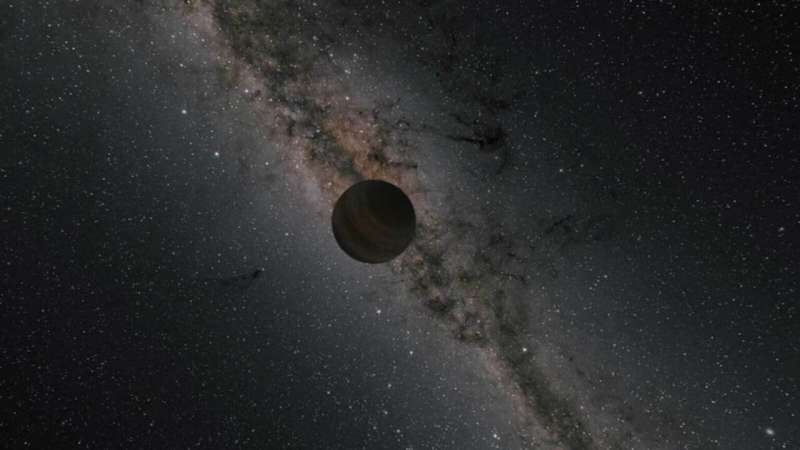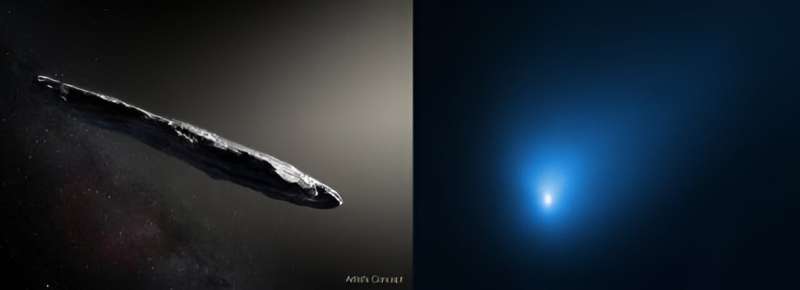This article has been reviewed according to Science X's editorial process and policies. Editors have highlighted the following attributes while ensuring the content's credibility:
fact-checked
peer-reviewed publication
trusted source
proofread
A new study shows how the sun could permanently capture rogue planets

Interest in interstellar objects (ISOs) was ignited in 2017 when 'Oumuamua flew through our solar system and made a flyby of Earth. Roughly two years later, another ISO passed through our solar system—the interstellar comet 2I/Borisov.
These encounters confirmed that ISOs are not only very common, but pass through our solar system regularly—something that astronomers have suspected for a long time. Even more intriguing is that some of these objects are captured and can still be found orbiting our sun.
In a recent study, a team of researchers described a region in the solar system where objects can be permanently captured from interstellar space. Their analysis determined that once objects are captured by our sun's gravitational pull and fall into this region—which could include comets, asteroids, and even rogue planets—they will remain in orbit around the sun and not collide with it. These findings could have drastic implications for ISO studies and proposed missions to rendezvous with some of these objects in the near future.
The research was conducted by Edward Belruno, a professor of mathematics with the Katz School of Science and Health at Yeshiva University, New York, and James Green, the Director of the Planetary Science Division at NASA Headquarters. Their findings were presented in a paper posted to the arXiv preprint server titled "Permanent Capture Into the Solar System," which was recently presented at Heidelberg University and to the trajectory dynamics group at the European Space Agency's Operations Centre (ESOC).
As noted, previous research has indicated that ISOs regularly visit our solar system and could even be responsible for seeding Earth with the building blocks of life. In addition, researchers have attempted to simulate how many of these objects are captured by our solar system over time, which yielded estimates in the thousands.
Last, but not least, the arrival of 'Oumuamua and 2I/Borisov also led to numerous proposals for spacecraft that could rendezvous with future ISOs and study them up close—such as the Interstellar Object Explorer (IOE) concept—or fly to those that our System has captured.

For their study, Belbrundo and Green performed simulations using a simplified model involving three masses—a captured ISO, the sun, and the Milky Way—which allowed them to recreate the motion of the captured object. As they describe in their paper, when ISOs get caught by the sun's gravitational pull, they can enter a state known as "permanent capture," where captured objects will remain in orbit around the sun indefinitely. In addition, these objects will also enter a state known as "weak capture," where they are slowly drawn into a stable orbit around the sun but never collide with it.
Their simulations showed that captured objects in this region can exhibit chaotic motion, making their orbits appear highly unpredictable. However, they also noted that the region exhibits a complex, repeating pattern, similar to a fractal (or the patterns seen in the Mandelbrot set in mathematics) that contributes to the stability of the captured object's orbit. As Belbruno explained to Astrobiology contributor Keith Cowing:
"The combined gravitational forces of the sun and the Milky Way play a crucial role in this process. The galaxy's gravitational field, including the effects of dark matter, significantly influences how objects are captured. Previous studies mainly focused on comet captures, which weren't always permanent. This new research, however, describes a mechanism that ensures a permanent capture."
Their study also suggests that in addition to asteroids and comets, the sun could capture rogue planets throughout eons. Recent research has shown that there could be trillions of rogue planets in the Milky Way that were kicked from their solar systems over time. The gravitational influence of captured rogue planets and other objects would cause perturbations in the orbits of other bodies in the solar system.
Similar to how astronomers have used the orbits of Kuiper Belt Objects to search for evidence of Planet 9 (aka. Planet X), astronomers could use these perturbations to infer the presence of captured bodies. Said Belbruno:
"The discovery not only enhances our understanding of gravitational dynamics but also opens up new possibilities for detecting and studying these fascinating celestial bodies. As we continue to explore the cosmos, who knows what other secrets the universe holds about the objects that have joined our solar family?"
More information: Edward Belbruno et al, Permanent Capture into the Solar System, arXiv (2024). DOI: 10.48550/arxiv.2407.09560
Journal information: Astrobiology , arXiv
Provided by Universe Today




















